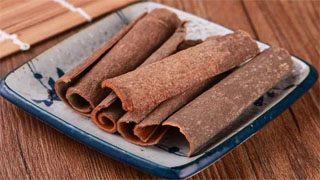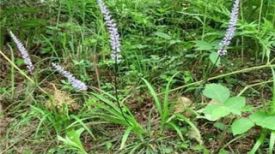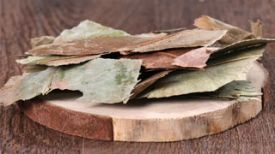
1. Aliases
Guangdong cinnamon.2. Plant morphology
Evergreen trees, up to 20 meters tall. The bark is smooth, gray brown or black brown, with a red endothelium and a taste similar to cinnamon. The leaves are alternate or nearly opposite, with a petiole length of 0.5-1.2 centimeters. The leaves are leathery, ovoid, oblong, or lanceolate, with a short gradually pointed tip and a wide wedge-shaped base, entire. Panicles axillary or near apical, 2-6 cm long, densely covered with grayish white pubescence, few flowers; Flowers bisexual, green white, covered with grayish white pubescence; Perianth tube inverted cone-shaped; Perianth lobes 6, oblong-ovate, approximately 2 millimeters long, apex acute; Capable of producing 9 stamens, with slightly soft hairs on the back and filaments of the anthers. The filaments are slightly longer than the anthers, and there is a pair of circular glands in the middle; Degenerated stamens 3, arrow shaped, pubescent, located in the innermost round; The ovary is nearly spherical, the style is slightly pubescent, and the stigma is disc-shaped. Fruit oval shaped; The fruit tray has teeth at the apex. The flowering period is from September to December, and the fruiting period is from November to March of the following year.
3. Origin distribution
Born in sparse forests, dense forests, shrubs, or by the roadside of streams. Distributed in Fujian, Guangdong, Guangxi, Hainan, and Yunnan.
4. Harvesting and processing
Peel the stem skin from May to July and dry it in the sun.
5. Characteristics of medicinal herbs
The stem skin is grooved or flaky, about 3 millimeters thick. The outer surface is brownish gray, rough, with circular raised skin pores and gray white lichen patches. Sometimes, the outer skin is scraped off and concave skin pore marks appear; The inner surface is brown and smooth. The texture is firm, and the inner layer of the cross-section is in a fragmented shape. The aroma is fragrant, with a slightly sweet and astringent taste.
6. Nature, taste, and meridian tropism
Warm in nature, with a spicy and sweet taste. Return to the Stomach Meridian, Large Intestine Meridian, Liver Meridian, and Kidney Meridian.
7. Effect and function
Warm to relieve pain, dispel wind and dispel cold, detoxify and reduce swelling, and stop bleeding. Belonging to warm internal medicine.
8. Clinical applications
Internal administration: decoction, dosage 6-9 grams; Or take the final product, 1.5-3 grams each time. External use: Mix and apply with wine at the end of grinding; Or soak in wine and apply. Indications: Cold stomach pain, abdominal pain, diarrhea, loss of appetite, wind cold dampness, lower back and leg pain, falls and injuries, traumatic bleeding, sores, boils, and toxins.
9. Pharmacological research
1. Anti ulcer effect: The water extract of Yinxiangpi was orally administered at 0.5 g (raw medicine)/kg and 2.5 g (raw medicine)/kg body weight for 3 consecutive days. It had a significant inhibitory effect on the formation of water immersed stress ulcers in mice, with an inhibition rate of 21,5% to 67.0%, and the effect was more pronounced at high doses. 2. Effects on Yang Deficiency Model: The water extract of Yinxiangpi was orally administered at 0.5 g (raw medicine)/kg and 2.5 g (raw medicine)/kg body weight for 6 consecutive days. It can inhibit thymic atrophy in Yang Deficiency mice caused by high-dose glucocorticoid flumethasone, with an inhibition rate of 16.7% to 50.0%. Small doses are better than large doses, but small doses have no protective effect on adrenal cortex function. Only high doses can reduce adrenal cholesterol content by 10.9%.
10. Chemical composition
The bark contains 0.2% to 0.4% volatile oil, and the main component in the oil is cinnamaldehyde, which accounts for about 77%. In addition, it also contains components such as eugenol and camphor.
11. Taboos for use
Not suitable for those with yin deficiency and excessive fire, blood heat bleeding, and pregnant women.
12. Compatibility prescription
① Treatment for cold stomach pain: 9 grams of Yin Xiang skin. Boiled in water. (Hong Kong Herbal Medicine)
② Treatment of falls and injuries: equal amounts of Yin Xiang bark and Yang Mei bark. At the end of the study, mix the wine and apply it to the injured area. (Fujian Pharmacopoeia)
③ Treatment of rheumatic joint pain: 6g of Yin Xiang skin and 30g of coarse leaved banyan root. Boiled in water. (Fujian Pharmacopoeia)
The content of the article is for clinical reference only. Non professionals in traditional Chinese medicine are not allowed to try medication.


